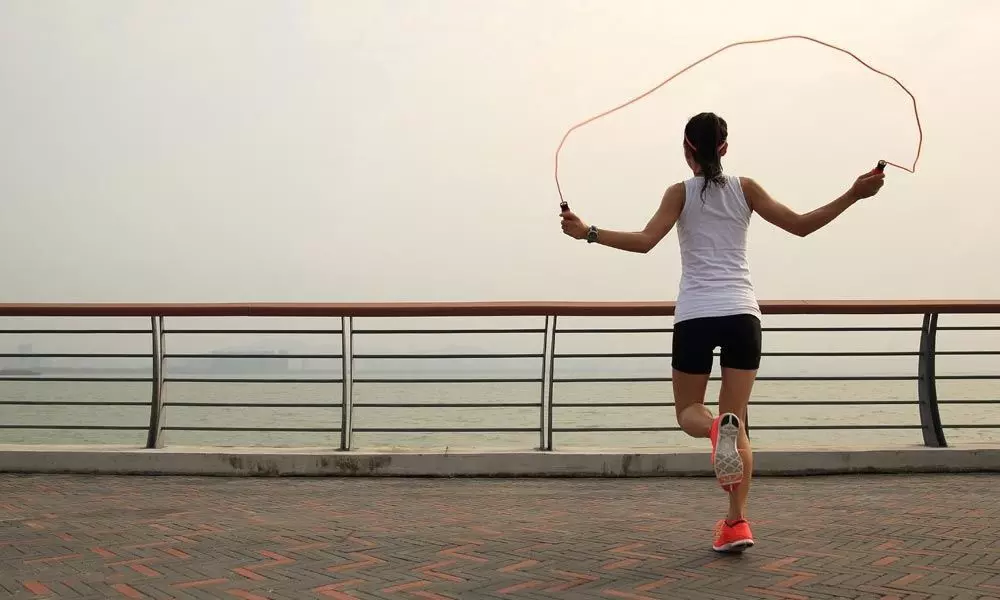Health Benefits Of Skipping

If you're looking for a fitness regime that focuses on your overall health, try skipping.
If you're looking for a fitness regime that focuses on your overall health, try skipping. There are a variety of wonderful health benefits of skipping that fitness experts swear by. Whether you want to stay fit or include skipping as a warm-up exercise in your workout schedule, skipping increases your physical strength and adds more to your immunity and stamina.
From boxers to athletes, there are a number of sportsmen around the globe who are practicing skipping and doing regular skipping exercises to stay in shape. Skipping helps to improve hand-to-eye coordination and preserves cardiovascular health in its best form. If you haven't already done it, it's best to start doing this incredible workout and reap the benefits of it for your wellbeing.
How to start skipping
Being one of the cheapest exercises available, it's open to everyone. Neither do you need a big workout room, nor do you need equipment to continue this journey on the road to fitness? You only need a sturdy skipping rope to start skipping, and you can practice this exercise wherever you want-be it outdoors in the garden or indoors in your home.
Skipping/jump rope
First of all, you need a jumping rope, which is fine, sturdy with a strong handle. It should be of a length that suits your height and is not too heavy, at least during the first few weeks of your training sessions. It is imperative that you choose a rope of the right size and weight. Skipping ropes are easily available in most sizes in all markets and sports retailers in India.
To start skipping, keep both handles in each hand and stand in the middle of the rope. Push the handles open up until the skipping rope is taut. Check if the handles are in the middle of your arms. If the rope is pulled out of proportion, change the handles and test again. You can launch your skipping session now. Do as many as physically possible in the beginning. Gradually, you can increase the number of jumps as per your stamina and need. If need be, you can take advise from any physio instructors to set a limit or plan for your skipping training sessions.
Cushioned training shoes
A good pair of shoes is a must if you are to begin skipping. Without proper feet support, skipping can impact your leg strength and bone activity. For your beginners' day, when you're going light on skipping, even bare-foot skipping can also work. However, as you march forward towards an advanced routine, it's best advised to provide lateral stability and support to your feet. Hence, it is suggested that you trust your feet with a pair of cushioned shoes.
Correct surface for skipping
Just as a good pair of shoes is critical for skipping, the correct surface to practice is also considered of equal importance. Skipping is best suited for' giving surfaces,' which ideally give you support, strength and bounce to jump back with physical strength. However, make sure the mat isn't slippery, or else you can have an accident. Beware of causing trouble to yourself, like shin splints.
There's no exercise that can't be honed over time with the right practice, time and dedication. Professional boxers trust boxing to aid their overall strength and full-body workout. it also adds on to their agility and stamina. Being a straight-forward form of exercise, skipping also needs a technique to help you garner the best of its benefits. Here are some techniques and tricks you should keep in mind.
• Maintain a balance and equal pressure on both feet when you land.
• Do not hunch over and maintain a straight back.
• When starting do not go for high jumps.
• Jump only a few centimetres into the air each time that the rope passes.
Tip: While skipping, do not look at your feet; keep your head straight and look ahead.
What else to keep in mind while skipping
Warm-up
For any form of physical exercise, it is important to give time to your body to warm up. This helps your muscles to get used to the pressure coming its way. Before skipping, you can walk, stretch, jog and do light jumping with the rope. After warming up, you can start the skipping session.
Technique practice
If you're new to skipping, focus on the technique, some people find it difficult to balance and to get a hang of the whole thing. However, with focus and technique, skipping can be done by one and all. Beginners also find skipping to be tiring. Hence, they should try lifting only a few centimeters in the air to let the rope pass. Keep your attention on the twirling action from the wrists rather than the shoulder. This will keep the motion smoother, lighter and quicker. You will attain peace and agility with regular practice.
Main skipping session
For beginners, even a few minutes of skipping can seem like a very exhausting job. However, this can be conquered with regular practice and time. This being a repetitive activity, the best way to do it is by integrating it with your other cardiovascular (CV) exercise. This is to get add a variety of training stimuli for maximum all-round fitness gains. Try to mix up 10 to 15 minutes of skipping with your regular cardiovascular (CV) exercise schedule.
Cool-down
As important are warm-ups, cooling down after any physical activity is imperative to bring your body back to its resting state. Ideally, end your skipping session with some stretching. Keep your focus on legs and calves area which are mostly-affected by the physical strain. This will also help in maintaining good leg flexibility.
Tips: Do not start the skipping session with high and heavy jumps. Start slow and gradually build up the pace to save yourself some injury.
After you've mastered the art of skipping, there's much more than you can do to maintain good physical strength. Here are some variations that will help your skipping workout regimen.
Double jump
Swing the skipping rope over your head and do a double step jump for each revolution.
Skip jump
Try using your one foot only to do skip jump. On each swing, kick the other foot in front or behind. Alternate this between both the feet.
Hop jump skipping
Hop jump
This one is more like hopping, but with a rope. Use your one foot and hop ceaselessly as you swing the rope. To begin with, try a couple of hops before moving to the next foot. After picking up pace, increase the number of hops.
Jog jump
This style is similar to jogging. DO quick sprints using the skipping rope as you twirl.
High jogging
This form of skipping exercise if one of the most demanding. Lift your knees as high as possible on each jump.
Skipping Benefits
Ski jump
Vaguely similar to double-footed jump, this skipping exercise is an advanced one. Jump a few centimeters off the floor, try this site on the side as well. You should begin this skipping style with short sideways jumps. After practice, you can extend the width of your jumps.
Cross-over
A classic practice by professional boxers, this skipping style is not for the faint-hearted. Use the double-jump technique and when the rope reaches your head, cross your arm and perform a higher jump to avoid tangling. Start from 10 skips and alter between standard and cross over skips each swing.
Tip: The best way to follow these techniques is by mastering them one by one. Skipping is a tedious task that exhausts the body, hence it is important to decide your own pace without going on in haste.
FAQs for skipping
FAQs for skipping
Q: How many calories will I burn if I start skipping?
A: By skipping for 10 minutes continuously, you can burn up as many calories as in a 30-minute run. Being a high-calorie burning exercise it is important for one to keep themselves hydrated.
Q: Where should I start?
A: The best possible way is to start at your home or nearby garden or park. You can also choose your gym's open area to start skipping. Begin with basic techniques and a slower pace and listen to your body's reaction as you go forward.
Q: 3. Are heavy ropes better than regular ones?
A: If you're looking for a professional, high-intensity workout, you can go for heavyweights. However, we'd advise you to practice this under supervision and only after being in a regular practice.















